Surface Characterization of AZ31 Alloy after Long-Term Immersion in Simulated Body Fluid
Abstract
:1. Introduction
2. Materials and Methods
3. Results and Discussion
- (1)
- In the beginning, the surface was covered by a thin layer of Mg(OH)2 that grew from screw dislocation sites.
- (2)
- From 7 to 28 days, Ca(PO3)2 crystals grew on the Mg hydroxide layer. Since the crystals did not homogeneously cover the entire surface, the biocorrosion rate was high.
- (3)
- The continuous release of Mg hydroxide in the solution gradually increased the pH of the SBF. The pH value and the higher Ca/P value of the SBF (Ca/P = 1.78) reached after 28 days favored the growth of crystals with higher Ca/P-Ca3(PO4)2, which covered the surface more homogeneously and decelerated the corrosion process. At the same time, the porous surface of the TCP crystals became covered in an organic film formed by the organic carbon group components of the SBF that protected the samples from further corrosion.
- (4)
- The slight presence of Al(OH)3, revealed by the tests, could have augmented the protective features of the surface layer.
4. Conclusions
- (1)
- The maximal weight loss observed after 56 days of biofluid immersion was 4% of the total weight. After 28 days, the corrosion process slowed down.
- (2)
- This study allowed the determination of the surface transformation mechanism of the samples: in the first stage (0–28 days), the surface was covered by a thick layer of Mg(OH)2, covered with crystals of Ca(PO3)2, and the corrosion rate was high; in the second stage (28–56 days), the appearance of homogeneously distributed Ca3(PO4)2 crystals covered by a film formed by the organic carbon group components of the SBF significantly decelerated the corrosion process.
- (3)
- The Mg(OH)2 crystals had a typical spiral growth for growth from screw dislocation.
Author Contributions
Funding
Data Availability Statement
Acknowledgments
Conflicts of Interest
References
- Mantripragada, V.P.; Lecka-Czernik, B.; Ebraheim, N.A.; Jayasuriya, A.C. An overview of recent advances in designing orthopedic and craniofacial implants. J. Biomed. Mater. Res. Part B Appl. Biomater. 2013, 101, 3349–3364. [Google Scholar] [CrossRef] [PubMed]
- Ng, W.F.; Chiu, K.Y.; Cheng, F.T. Effect of pH on the in vitro corrosion rate of magnesium degradable implant material. Mater. Sci. Eng. C 2010, 30, 898–903. [Google Scholar] [CrossRef]
- Aspenberg, P. Silk, metal and bone: Why take implants out? Nat. Rev. Rheumatol. 2014, 10, 386–387. [Google Scholar] [CrossRef] [PubMed]
- Peustera, M.; Wohlseinb, P.; Brügmannb, M.; Ehlerdinga, M.; Seidlera, K.; Finka, C.; Brauerc, H.; Fischerc, A.; Hausdorfa, G. A novel approach to temporary stenting: Degradable cardiovascular stents produced from corrodible metal-results 6–18 months after implantation into New Zealand white rabbits. Heart 2001, 86, 563–569. [Google Scholar] [CrossRef] [PubMed]
- Feng, Q.; Zhang, D.; Xin, C.; Liu, X.; Lin, W.; Zhang, W.; Chen, S.; Sun, K. Characterization and in vivo evaluation of a bio-corrodible nitrided iron stent. J. Mater. Sci. Mater. Med. 2013, 24, 713–724. [Google Scholar] [CrossRef] [PubMed]
- Schinhammer, M.; Hänzi, A.C.; Löffler, J.F.; Uggowitzer, P.J. Design strategy for biodegradable Fe-based alloys for medical applications. Acta Biomater. 2010, 6, 1705–1713. [Google Scholar] [CrossRef]
- Vojtěch, D.; Kubásek, J.; Šerák, J.; Novák, P. Mechanical and corrosion properties of newly developed biodegradable Zn-based alloys for bone fixation. Acta Biomater. 2011, 7, 3515–3522. [Google Scholar] [CrossRef]
- Chen, Y.; Xu, Z.; Smith, C.; Sankar, J. Recent advances on the development of magnesium alloys for biodegradable implants. Acta Biomater. 2014, 10, 4561–4573. [Google Scholar] [CrossRef]
- Chen, K.; Dai, J.; Zhang, X. Improvement of corrosion resistance of magnesium alloys for biomedical applications. Corros. Rev. 2015, 33, 101–117. [Google Scholar] [CrossRef]
- Zhao, D.; Witte, F.; Lu, F.; Wang, J.; Li, J.; Qin, L. Current status on clinical applications of magnesium-based orthopaedic implants: A review from clinical translational perspective. Biomaterials 2017, 112, 287–302. [Google Scholar] [CrossRef]
- Ramirez, O.; Ceccarelli, M.; Russo, M.; Torres-San-Miguel, C.R.; Urriolagoitia-Calderon, G. Experimental Dynamic Tests of Rib Implants. Adv. Ital. Mech. Sci. 2019, 2019, 353–361. [Google Scholar]
- Arrequin, J.L.; Montanari, R.; Ceccarelli, M.; Ambrogi, V.; Richetta, M.; Torres-San-Miguel, C.R.; Varone, A. Design solutions from material selection for rib fixators. Mater. Sci. Forum 2021, 1016, 303–308. [Google Scholar]
- Witte, F.; Fischer, J.; Nellesen, J.; Crostack, H.-A.; Kaese, V.; Pisch, A.; Beckmann, F.; Windhagen, H. In vitro and in vivo corrosion measurements of magnesium alloys. Biomaterials 2006, 27, 1013–1018. [Google Scholar] [CrossRef] [PubMed]
- Shuai, C.; Li, S.; Peng, S.; Feng, P.; Lai, Y.; Gao, C. Biodegradable metallic bone implants. Mater. Chem. Front. 2019, 3, 544–562. [Google Scholar] [CrossRef]
- Pompa, L.; Rahman, Z.U.; Munoz, E.; Haider, W. Surface characterization and cytotoxicity response of biodegradable magnesium alloys. Mater. Sci. Eng. C 2015, 49, 761–768. [Google Scholar] [CrossRef] [PubMed]
- Istrate, B.; Munteanu, C.; Bălțatu, M.-S.; Cimpoeșu, R.; Ioanid, N. Microstructural and Electrochemical Influence of Zn in MgCaZn Biodegradable Alloys. Materials 2023, 16, 2487. [Google Scholar] [CrossRef] [PubMed]
- Xin, Y.; Hu, T.; Chu, P.K. In vitro studies of biomedical magnesium alloys in a simulated physiological environment: A review. Acta Biomater. 2011, 7, 1452–1459. [Google Scholar] [CrossRef] [PubMed]
- Chen, Y.; Dou, J.; Yu, H.; Chen, C. Degradable magnesium-based alloys for biomedical applications: The role of critical alloying elements. J. Biomater. Appl. 2019, 33, 1348–1372. [Google Scholar] [CrossRef]
- Alvarez-Lopez, M.; Pereda, M.D.; del Valle, J.; Fernandez-Lorenzo, M.; Garcia-Alonso, M.C.; Ruano, O.A.; Escudero, M.L. Corrosion behaviour of AZ31 magnesium alloy with different grain sizes in simulated biological fluids. Acta Biomater. 2010, 6, 1763–1771. [Google Scholar] [CrossRef]
- Feng, H.; Liu, S.; Du, Y.; Lei, T.; Zeng, R.; Yuan, T. Effect of the second phases on corrosion behavior of the Mg–Al–Zn alloys. J. Alloys Compd. 2017, 695, 2330–2338. [Google Scholar] [CrossRef]
- Jiang, H.; Li, F.; Zeng, X. Microstructural characteristics and deformation of magnesium alloy AZ31 produced by continuous variable cross-section direct extrusion. J. Mater. Sci. Technol. 2017, 33, 573–579. [Google Scholar] [CrossRef]
- Anuradha, J.; Mitun, D.; Vamsi, K.B. Effect of heat treatment on microstructure, mechanical, corrosion and biocompatibility of Mg-Zn-Zr-Gd-Nd alloy. J. Alloys Compd. 2020, 821, 153462. [Google Scholar]
- Linyuan, H.; Xuan, L.; Feng, X.; Chenglin, C.; Jing, B. Biocorrosion behavior of micro-arc-oxidized AZ31 magnesium alloy in different simulated dynamic physiological environments. Surf. Coat. Technol. 2019, 361, 240–248. [Google Scholar]
- Zhicheng, L.; Zhenzhen, S.; Xian, W.; Qing, Z. Corrosion resistance and cytotoxicity of AZ31 magnesium alloy with N+ ion implantation. Mater. Technol. 2019, 34, 730–736. [Google Scholar]
- Peron, M.; Skaret, P.C.; Fabrizi, A.; Varone, A.; Montanari, R.; Roven, H.J.; Ferro, P.; Berto, F.; Torgersen, J. The effect of Equal Channel Angular Pressing on the stress corrosion cracking susceptibility of AZ31 alloy in simulated body fluid. J. Mech. Behav. Biomed. Mater. 2020, 106, 103724. [Google Scholar] [CrossRef] [PubMed]
- Mohajernia, S.; Pour-Ali, S.; Hejazi, S.; Saremi, M.; Kiani-Rashid, A.-R. Hydroxyapatite coating containing multi-walled carbon nanotubes on AZ31 magnesium: Mechanical-electrochemical degradation in a physiological environment. Ceram. Int. 2018, 44, 8297–8305. [Google Scholar] [CrossRef]
- Zeng, R.C.; Hu, Y.; Guan, S.K.; Cui, H.-Z.; Han, E.-H. Corrosion of magnesium alloy AZ31: The influence of bicarbonate, sulphate, hydrogen phosphate and dihydrogen phosphate ions in saline solution. Corros. Sci. 2014, 86, 171–182. [Google Scholar] [CrossRef]
- Wang, L.; Shinohara, T.; Zhang, B.P. Influence of chloride, sulfate and bicarbonate anions on the corrosion behavior of AZ31 magnesium alloy. J. Alloys Compd. 2010, 496, 500–507. [Google Scholar] [CrossRef]
- Walker, J.; Shadanbaz, S.; Kirkland, N.T.; Stace, E.; Woodfield, T.; Staiger, M.P.; Dias, G.J. Magnesium alloys: Predicting in vivo corrosion with in vitro immersion testing. J. Biomed. Mater. Res. Part B Appl. Biomater. 2012, 100, 1134–1141. [Google Scholar] [CrossRef]
- Ambrogi, V.; Bolli, E.; Ceccarelli, M.; Kaciulis, S.; Mezzi, A.; Montanari, R.; Pakhomova, E.; Richetta, M.; Varone, A. Surface modifications of biodegradable AZ31 alloy after immersion in physiological solution. Surf. Interface Anal. 2023, 55, 474–479. [Google Scholar] [CrossRef]
- JCPDS-International Centre for Diffraction Data. Available online: https://www.icdd.com (accessed on 29 November 2023).
- Yang, L.; Zhang, E. Biocorrosion behavior of magnesium alloy in different simulated fluids for biomedical application. Mater. Sci. Eng. C 2009, 29, 1691–1696. [Google Scholar] [CrossRef]
- Gu, X.N.; Zheng, Y.F.; Chen, L.J. Influence of artificial biological fluid composition on the biocorrosion of potential orthopedic Mg–Ca, AZ31, AZ91 alloys. Biomed. Mater. 2009, 4, 065011. [Google Scholar] [CrossRef] [PubMed]
- Shadanbaz, S.; Dias, G.J. Calcium phosphate coatings on magnesium alloys for biomedical applications: A review. Acta Biomater. 2012, 8, 20–30. [Google Scholar] [CrossRef] [PubMed]
- Omar, S.A.; Ballarre, J.; Schreiner, W.H.; Ceré, S.M. Micro Raman and XPS surface analysis to understand the electrochemical behaviour of AZ31 and AZ91 magnesium alloys as temporary implant materials. Mater. Today Commun. 2022, 31, 103557. [Google Scholar] [CrossRef]
- Khan, A.F.; Awais, M.; Khan, A.S.; Tabassum, S.; Chaudhry, A.A.; Rehman, I.U. Raman Spectroscopy of Natural Bone and Synthetic Apatites. Appl. Spectrosc. Rev. 2013, 48, 329–355. [Google Scholar] [CrossRef]
- Takeuchi, H.; Ohtsuka, Y.; Harada, I. Ultraviolet Resonance Raman Study on the Binding Mode of Enkephalin to Phospholipid Membranes. J. Am. Chem. Soc. 1992, 114, 5321–5328. [Google Scholar] [CrossRef]
- Mindivan, H.; Kayali, E.S.; Cimenoglu, H. Tribological behavior of squeeze cast aluminum matrix composites. Wear 2008, 265, 645–654. [Google Scholar] [CrossRef]
- Lin-Vien, D.; Colthup, N.B.; Fateley, W.G.; Grasselli, J.G. The Handbook of Infrared and Raman Characteristic Frequencies of Organic Molecules; Elsevier: Amsterdam, The Netherlands, 1991; pp. 83–90. [Google Scholar]
- Phillips, V.A.; Kolbe, J.L.; Opperhauser, H. Effect of pH on the growth of Mg(OH)2 crystals in an aqueous environment at 60 °C. J. Cryst. Growth 1977, 41, 228–234. [Google Scholar] [CrossRef]

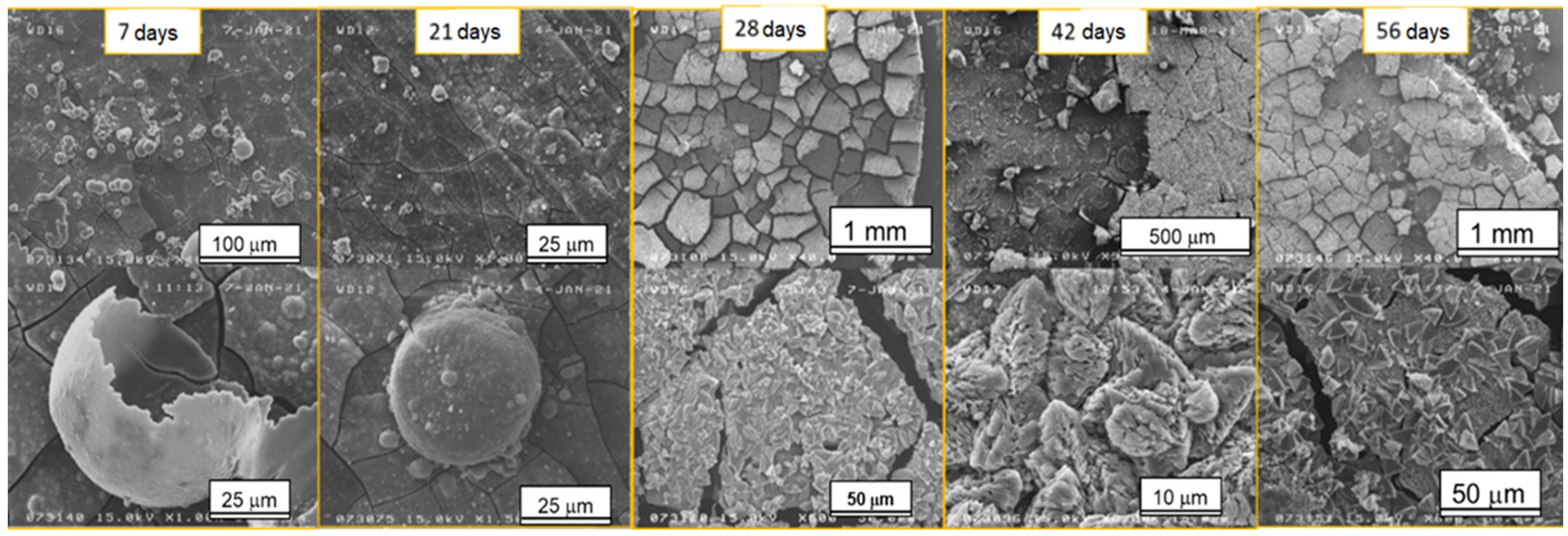




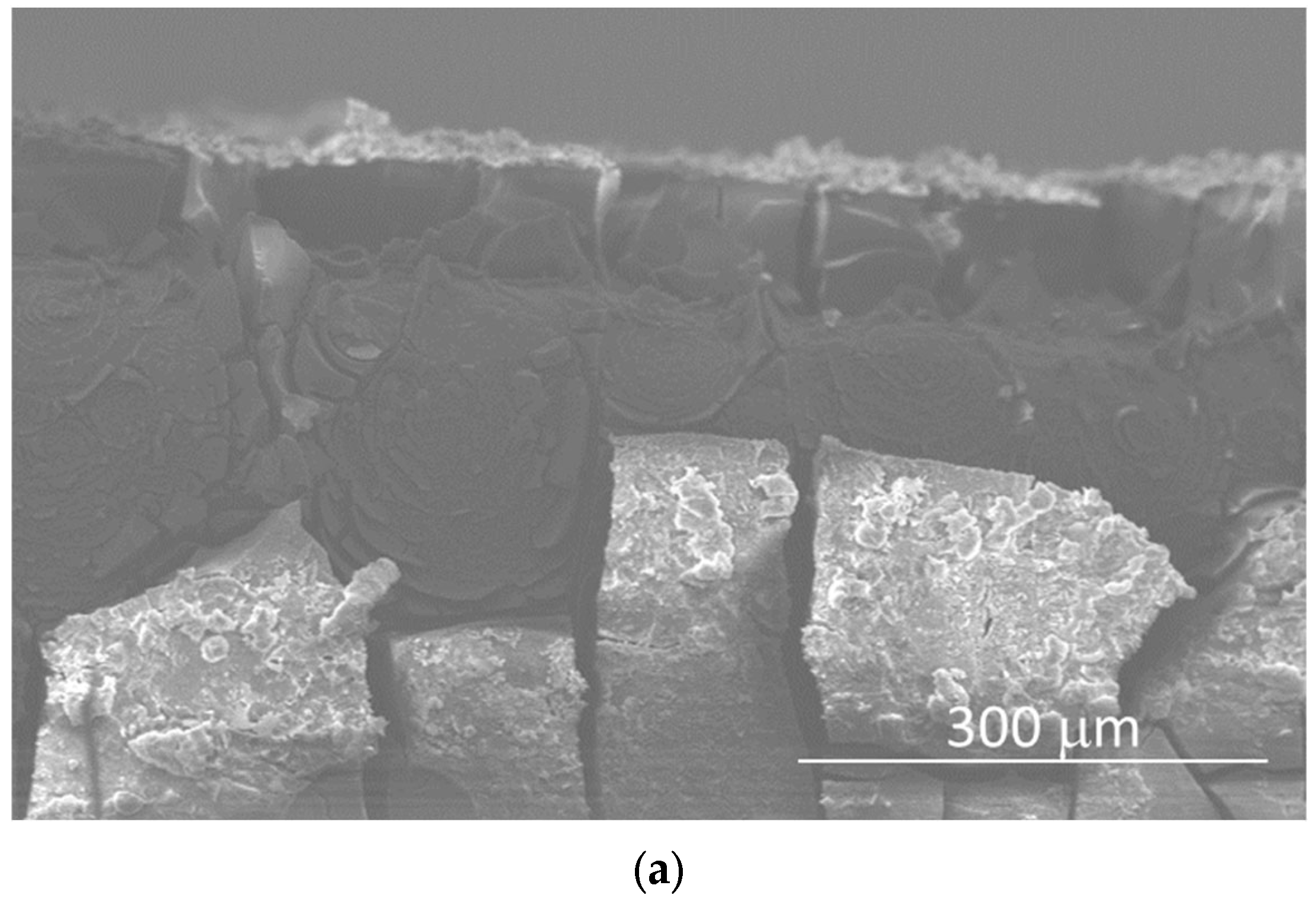
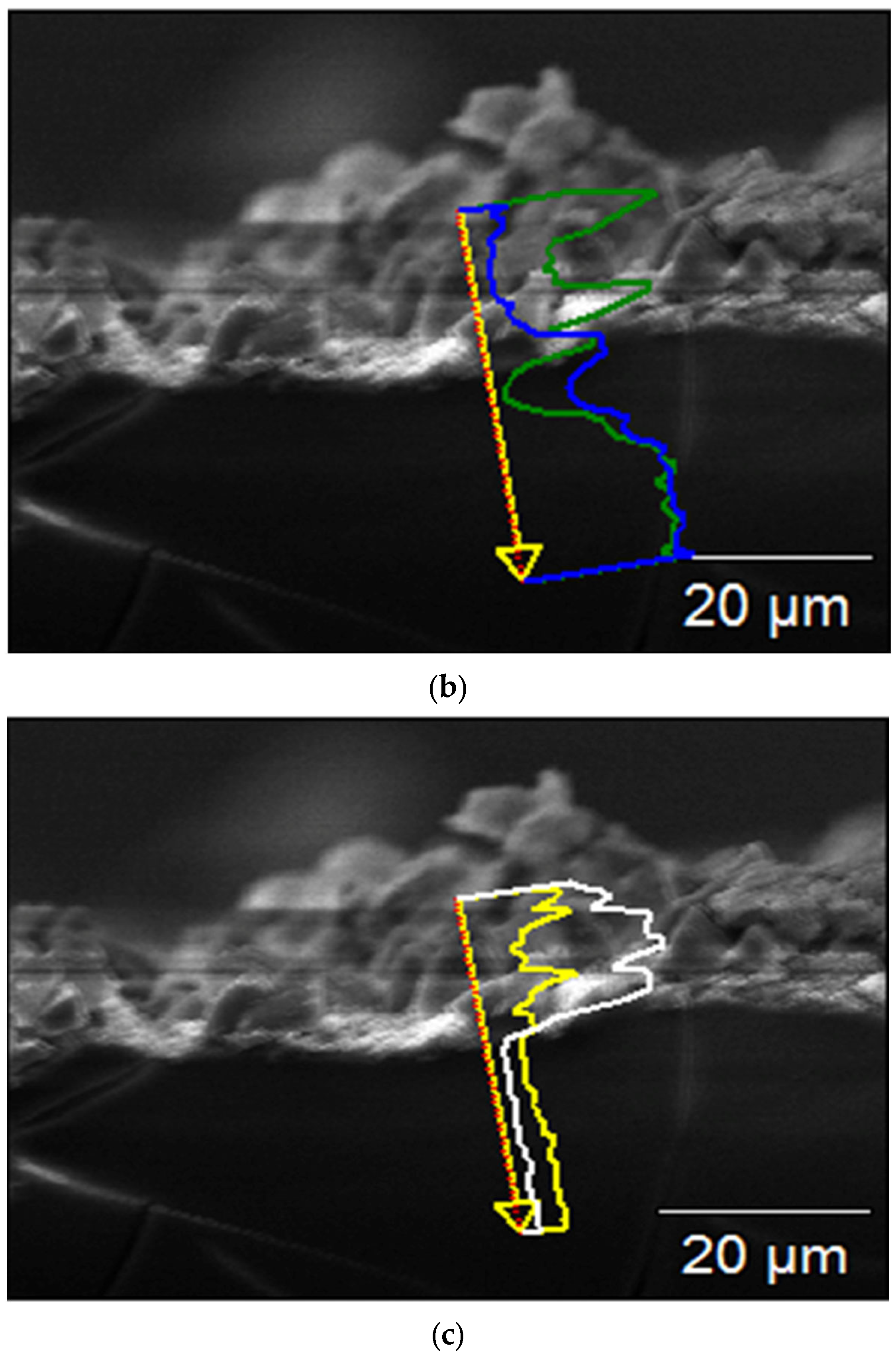
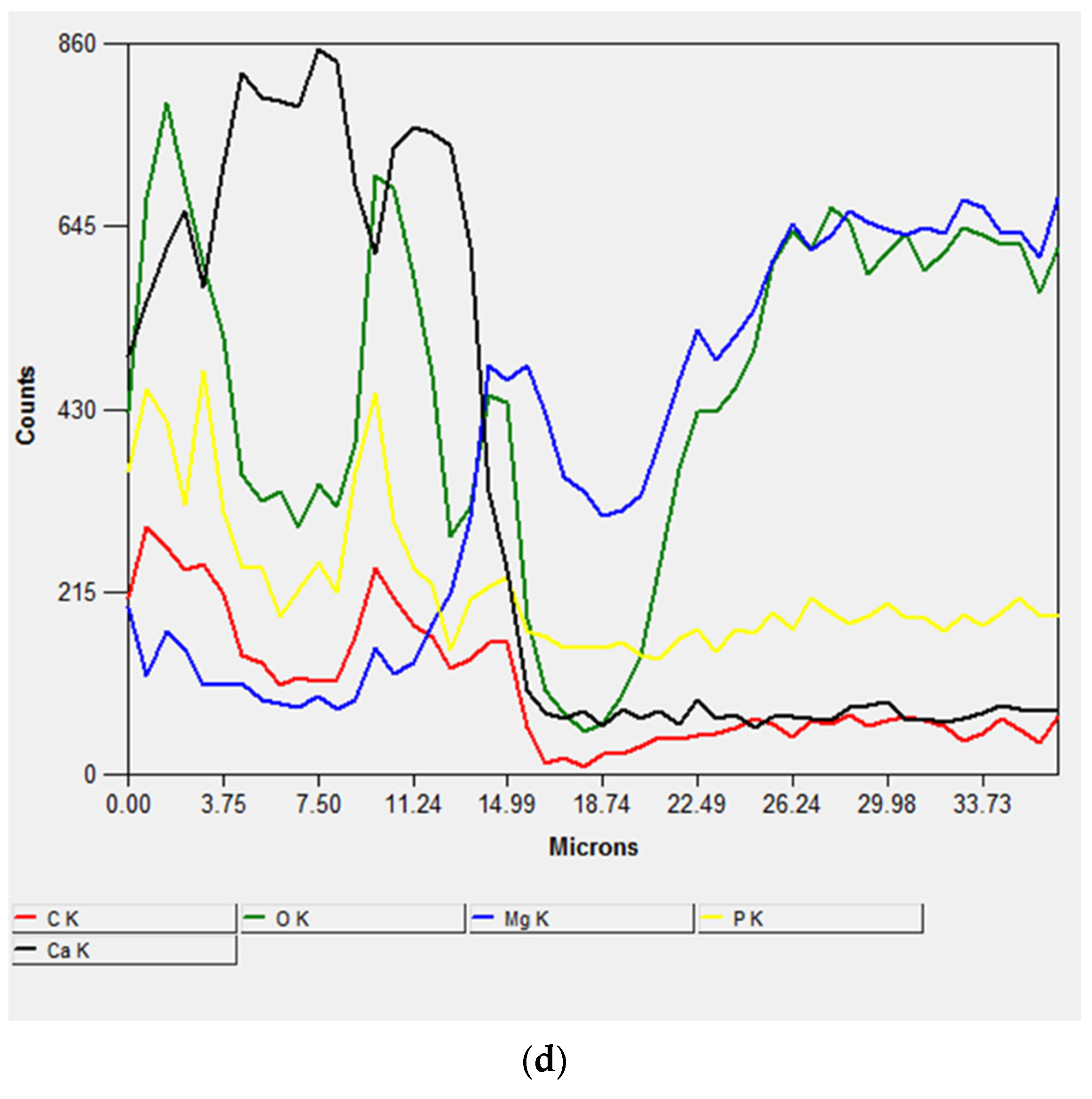

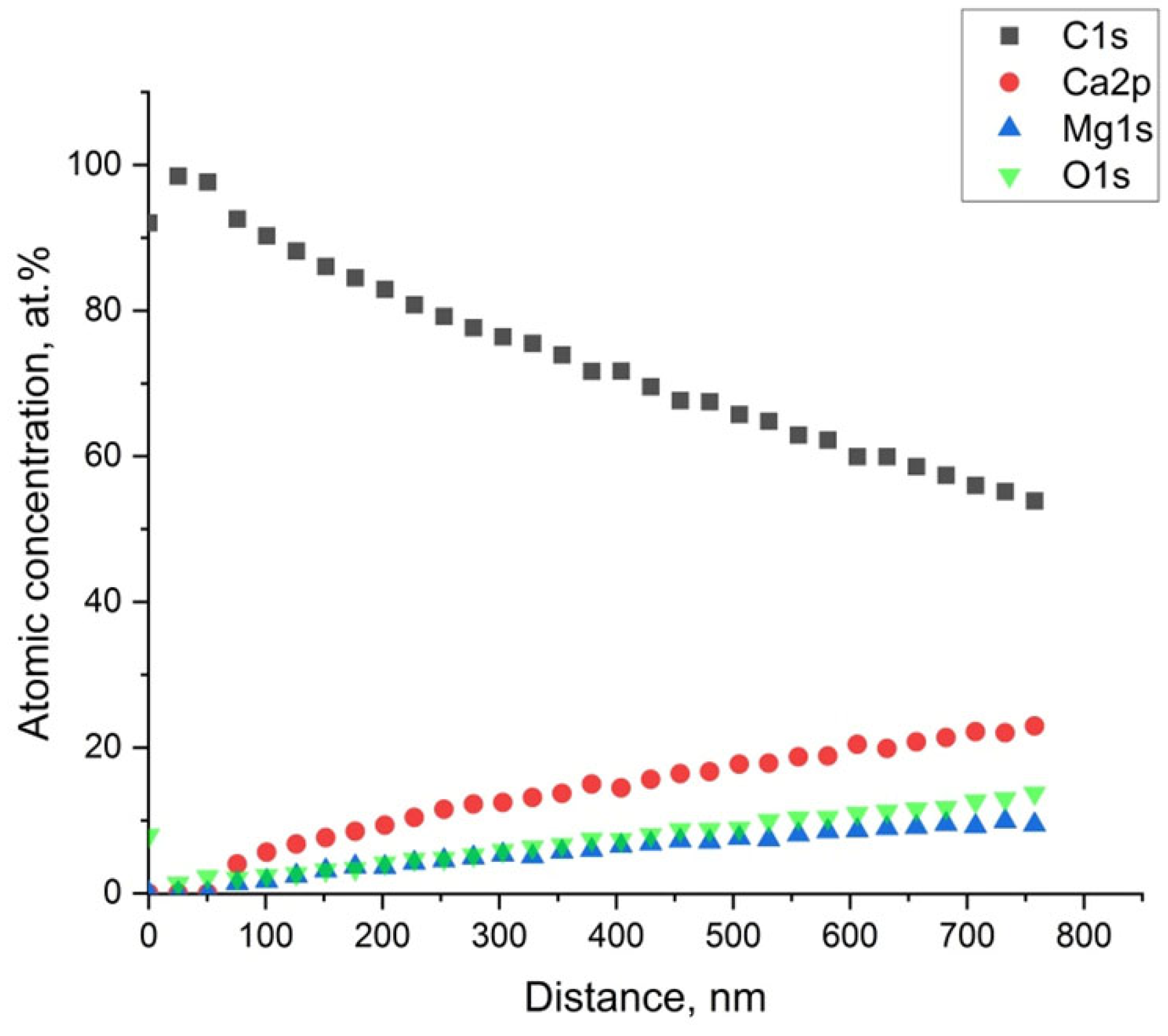
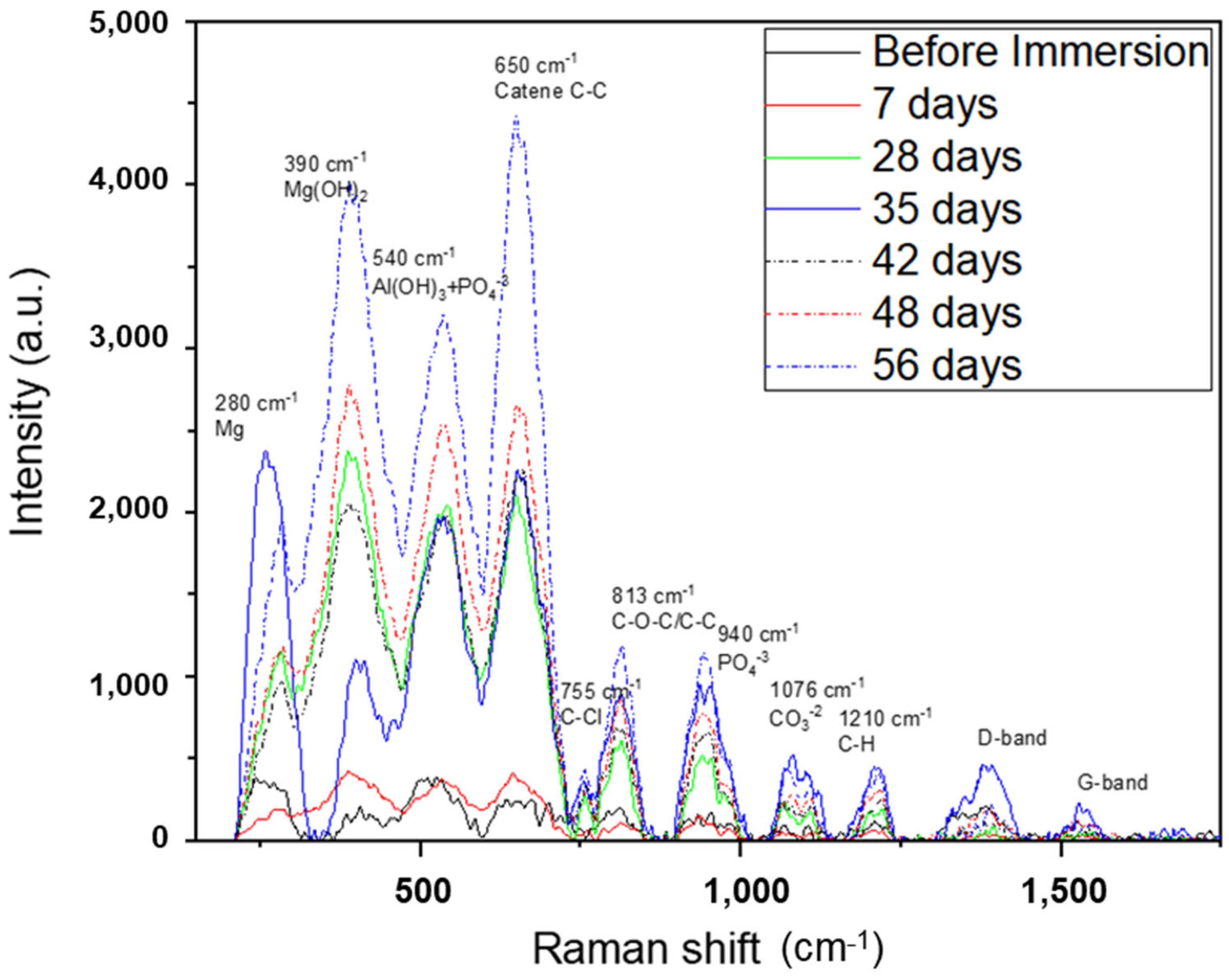
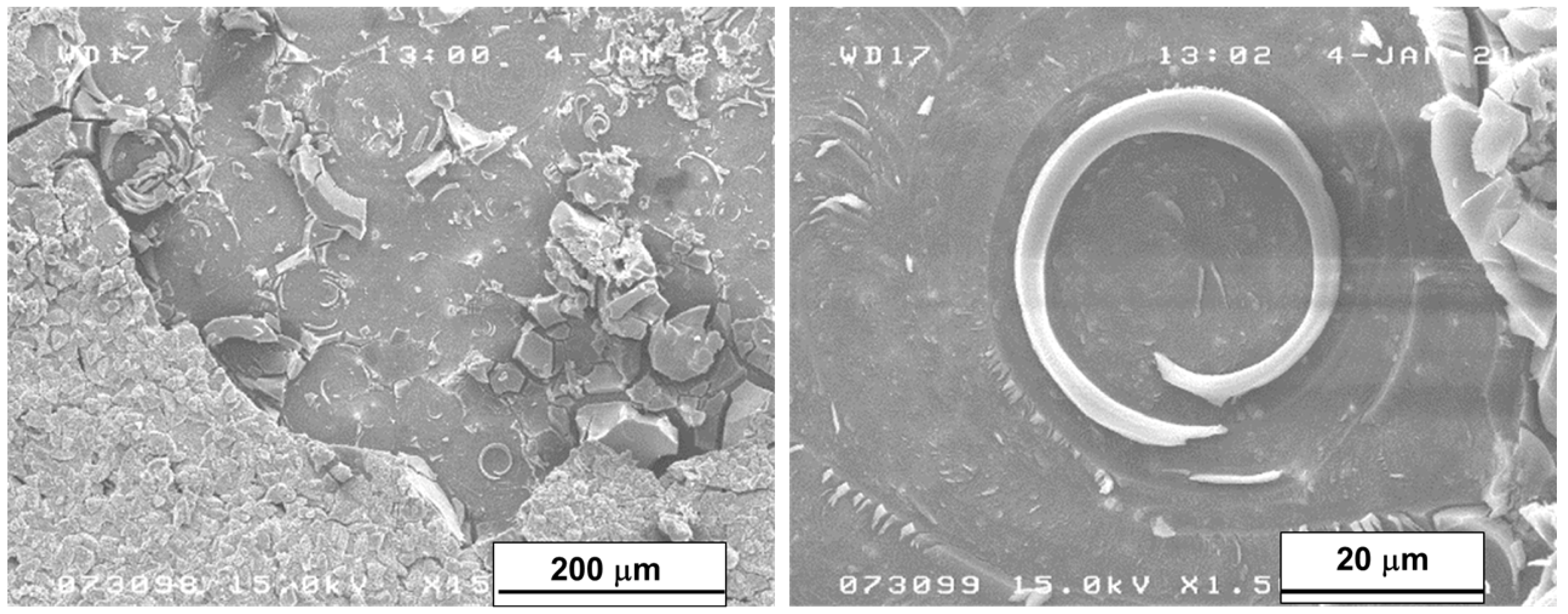
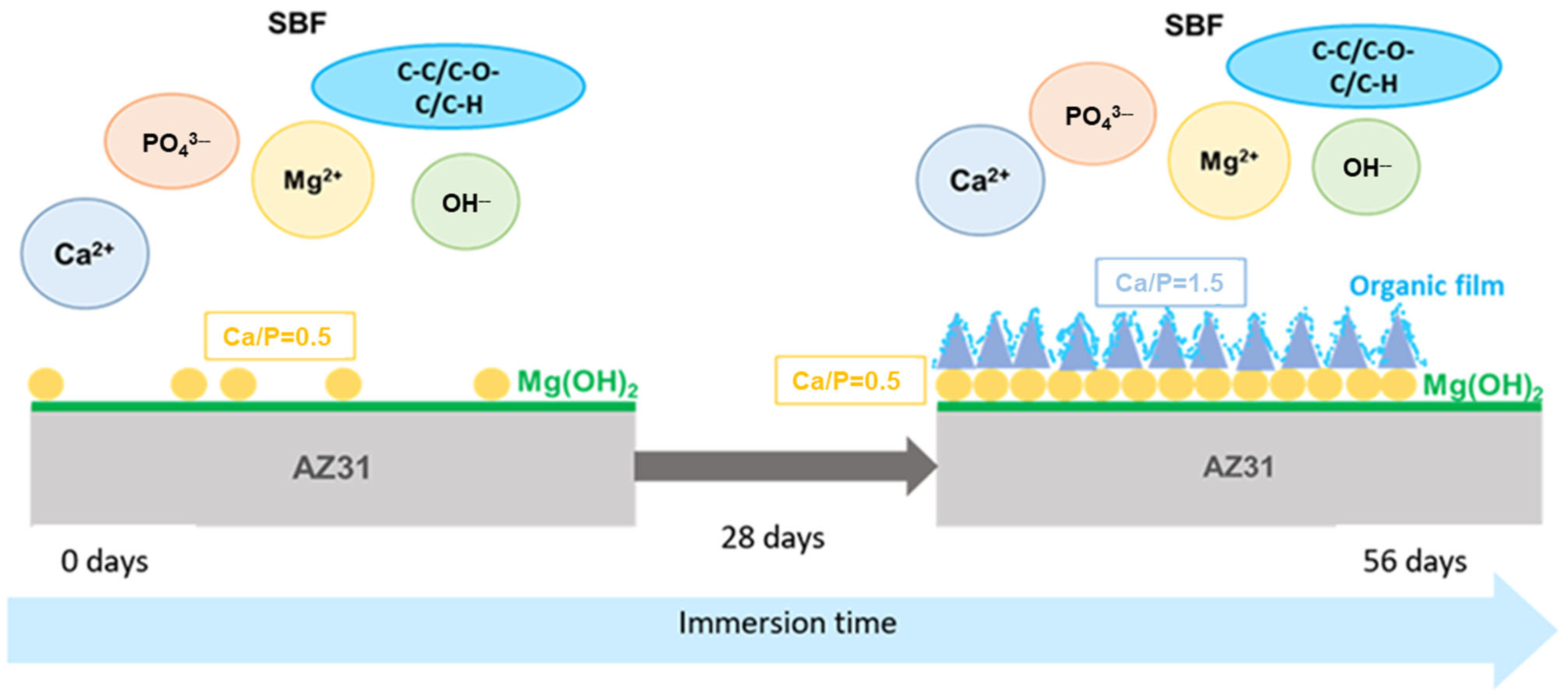
| Immersion Time (Days) | pH Value |
|---|---|
| 3 | 7.71 |
| 7 | 8.24 |
| 10 | 7.82 |
| 14 | 8.38 |
| 21 | 8.38 |
| 28 | 8.45 |
| 35 | 8.45 |
| 42 | 8.58 |
| 48 | 8.51 |
| 56 | 8.54 |
| Days of Immersion | C1s-1 | C1s-2 | C1s-3 | C1s-4 | O1s-1 | O1s-2 | N1s-1 | N1s-2 | P2p3 | Ca2p3 | Mg1s | ||
|---|---|---|---|---|---|---|---|---|---|---|---|---|---|
| C-C | C-O | C = O | Carbonates | Oxides, C-O | C = O | Amine | Ammonium | Phosphate | CaO | Mg Oxide | |||
| 7 | BE (eV) | 284.8 | 286.2 | 288.2 | 289.7 | 531.3 | 533.7 | 400 | 402.4 | 132.9 | 347.4 | 1304.0 | |
| At.% | 26.9 | 22.4 | 11.3 | 1.3 | 15.8 | 5.1 | 10.6 | 1.3 | 1.5 | 2 | 1.8 | ||
| 14 | BE (eV) | 284.8 | 286 | 288 | 289.6 | 531.2 | 533.1 | 399.8 | 402.2 | 132.7 | 347.2 | 1303.8 | |
| At.% | 21 | 17.5 | 13.5 | 1.6 | 19.8 | 6.1 | 12.1 | 1.3 | 1.6 | 1.4 | 4.1 | ||
| 21 | BE (eV) | 284.8 | 286.7 | 288.4 | 290.4 | 531.4 | 533.8 | 400 | 403.3 | 133.5 | 347.2 | 1304.4 | |
| At.% | 31.9 | 17.8 | 7.7 | 2.4 | 19.3 | 6.5 | 4.4 | 0.9 | 3.3 | 2.6 | 3 | ||
| 28 | BE (eV) | 284.8 | 286.8 | 288.4 | 290.1 | 532.0 | 534.8 | 347.1 | 1304.1 | ||||
| At.% | 26.7 | 8.8 | 5.3 | 5.8 | 31.2 | 7.0 | 3.6 | 11.6 | |||||
| Al2p3/2 | |||||||||||||
| 35 | BE (eV) | 284.8 | 286.3 | 288.3 | 290.1 | 531.6 | 534.7 | 1304 | 74.3 | ||||
| At.% | 40.2 | 3.4 | 2.8 | 4.3 | 33.7 | 1.7 | 10.4 | 3.5 | |||||
| Al2O3, Al(OH)3 | |||||||||||||
| Si2p3 | |||||||||||||
| 42 | BE (eV) | 284.8 | 286.5 | 288.5 | 290.4 | 532.1 | 347.9 | 102.2 | |||||
| At.% | 44.9 | 33.1 | 2.5 | 1.4 | 12.8 | 2.9 | 2.4 | ||||||
| Si-O | |||||||||||||
| 48 | BE (eV) | 284.8 | 286.4 | 288.3 | 289.8 | 531.9 | |||||||
| At.% | 55.8 | 33.4 | 2.4 | 1 | 7.5 | ||||||||
| 56 | BE (eV) | 284.8 | 286.3 | 288.1 | 289.8 | 532 | |||||||
| At.% | 89.4 | 7.2 | 2.5 | 0.8 | <0.1 |
Disclaimer/Publisher’s Note: The statements, opinions and data contained in all publications are solely those of the individual author(s) and contributor(s) and not of MDPI and/or the editor(s). MDPI and/or the editor(s) disclaim responsibility for any injury to people or property resulting from any ideas, methods, instructions or products referred to in the content. |
© 2023 by the authors. Licensee MDPI, Basel, Switzerland. This article is an open access article distributed under the terms and conditions of the Creative Commons Attribution (CC BY) license (https://creativecommons.org/licenses/by/4.0/).
Share and Cite
Pakhomova, E.; Varone, A.; Mezzi, A.; Fava, A.; Manis, C.; Loy, F.; Palombi, A.; Cao, G. Surface Characterization of AZ31 Alloy after Long-Term Immersion in Simulated Body Fluid. Crystals 2023, 13, 1692. https://doi.org/10.3390/cryst13121692
Pakhomova E, Varone A, Mezzi A, Fava A, Manis C, Loy F, Palombi A, Cao G. Surface Characterization of AZ31 Alloy after Long-Term Immersion in Simulated Body Fluid. Crystals. 2023; 13(12):1692. https://doi.org/10.3390/cryst13121692
Chicago/Turabian StylePakhomova, Ekaterina, Alessandra Varone, Alessio Mezzi, Alessandra Fava, Cristina Manis, Francesco Loy, Alessandra Palombi, and Giacomo Cao. 2023. "Surface Characterization of AZ31 Alloy after Long-Term Immersion in Simulated Body Fluid" Crystals 13, no. 12: 1692. https://doi.org/10.3390/cryst13121692
APA StylePakhomova, E., Varone, A., Mezzi, A., Fava, A., Manis, C., Loy, F., Palombi, A., & Cao, G. (2023). Surface Characterization of AZ31 Alloy after Long-Term Immersion in Simulated Body Fluid. Crystals, 13(12), 1692. https://doi.org/10.3390/cryst13121692









